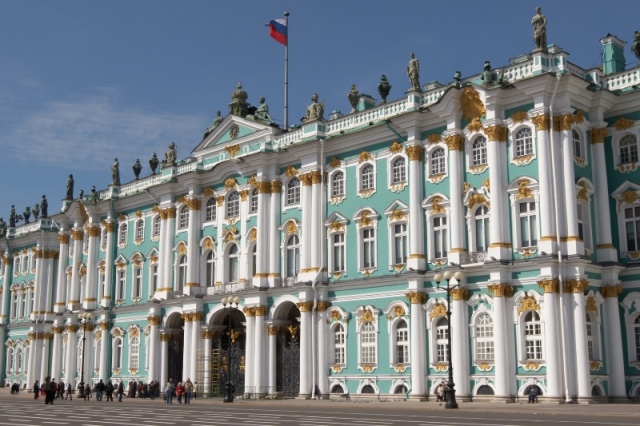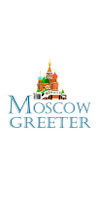
The State Hermitage in Saint Petersburg
The Main Museum Complex address: 2, Palace Square
Website: http://www.hermitagemuseum.org
Phone: (812) 710-90-79
How to get there: Metro stations “Nevsky Prospect”, “Gostiny Dvor”; trolley buses 1, 7, 10, 11, buses 7, 10, 24, 187 to station “The State Hermitage”.
Entrance from the Palace Square
Opening hours:
Tuesdays – Saturdays: 10.30-18.00
Sundays: 10.30 - 17.00
Closed Mondays.
Ticket windows are shut one hour before the museum closes.
On holidays and days preceding holidays (except Mondays and January 1), the museum is open from 10.30 to 17.00.
Tickets / Entrance fee:
A regular entrance ticket to the State Hermitage allows visiting the complex of Hermitage buildings located on Palace Embankment that contain the main exhibition halls. It gives access to the museum displays housed in five interconnected buildings. Price is US $17.95 (200 Rub.).
A combined entrance ticket to the State Hermitage allows visiting all the museum facilities operated by the State Hermitage in St. Petersburg in two consecutive days, including: the main displays located in the five interconnected buildings of the museum on Palace Embankment; the displays in the General Staff building on Palace Square and the Menshikov Palace on University Embankment; the Winter Palace of Peter the Great down the Palace Embankment from the main complex; the Porcelain Museum on Prospekt Obukhovskoy oborony. The price is US400 Rub.
Entrance ticket for foreign citizens working at the institutions accredited at the territory of the Russian Federation and having a residence permit issued by the Ministry of Internal Affairs of the Russian Federation costs 100 rubles (corresponding documents must be presented: passport, ID, residence permit).
Free entrance ticket is for children of preschool and school age, students (irrespective of their citizenship).
First Thursday of each month – free admission to the museum for all categories of individual visitors (for free tickets).
English language use: Web-site is available in English. Visitor information is available in English, German, French, Spanish, Korean, Chinese. Visitors from abroad can also enjoy tours in European languages: English, French, German, Italian, and Spanish. Audio-guides for 350 Rub are available in English, French, German, Italian, and Spanish as well.
Taking pictures: Ticket for amateur photography and video costs 200 rubles.
“The Hermitage is so good that I traveled 20,000 km twice to see it!” – Said one of the visitors, and millions of people are ready to share her opinion.
St. Petersburg is a fantastic, beautiful and at the same time historic city packed with sights to see, but the high-spot of any tour here definitely should be a visit to the Winter Palace - the fabulous white, green and gold residence of the tsars that is situated by the side of the River Neva. The Winter Palace includes the State Hermitage Museum, one of the world's greatest art galleries - a gallery so unique that it is worth traveling all the way to Russia many times just to see it.
Of course it is up to you to decide whether to visit this museum for the sake of appearance or to examine each of its wonderful halls to a nail. Anyhow it is one of the places that one should see one way or another durante vita.
Overview:
The State Hermitage is one of the largest and oldest museums in the world. Its collections comprise nearly 3 million items. The museum's storerooms, exhibitions, departments and services are housed in 10 buildings, 7 of which are monuments of 18th- and 19th-Century Russian culture. The Winter Palace that comprises the main collection of the state museum has 1,057 halls and rooms. It is one of the most luxurious places on the face of our planet. One can find here miracles from every corner of the world, from Egyptian mummies to Picasso’s great paintings.
Just fancy! Only the ground floor of this fabulous museum covers the Egyptian collection, a collection of the culture of Ancient Mesopotamia, including a number of Assyrian reliefs from Babylon, a collection of Classical Antiquities with Greek artifacts from the 3rd millennium to 5th Century BC, Italic art from the 9th to 2nd Century BC, Roman marble and bronze sculpture and applied art from the 1st Century BC to 4th Century AD, including copies of Classical and Hellenistic Greek sculptures. There are also the prehistoric artifacts that date from the Paleolithic to the Iron Age and were excavated all over Russia. The fantastic ground floor also comprises treasure galleries, featuring western and Asian jewellery from the 4th millennium BC to the early 20th century AD.
For admirers of the Western European Art there is a great collection that includes European paintings, sculptures, applied art from the 13th to the 20th Century and is on display in about 120 rooms on the first and second floor in four buildings. There are works of great Italian Renaissance artists, such as Titian, Raphael and Leonardo da Vinci; Italian and Spanish canvases, including Michelangelo’s Crouching boy and paintings by El Greco.
All children are always deeply impressed by the Knights' Hall, a large room in the eastern part of the New Hermitage originally designed in the Greek revival style for the display of coins, that now hosts a collection of Western European arms and armour of the 15th-17th Centuries, part of the Hermitage Arsenal collection.
The rooms of the southern facade and the western wing of the New Hermitage are now entirely allocated to Dutch Golden Age and Flemish Baroque painting of the 17th Century, including the large collections of A. Van Dyck, Rubens and Rembrandt. And this collection is strikingly enormous.
There are collections of German, French, Russian fine art; neoclassical, impressionist, post-impressionist and modern art. Visitors can see with their own eyes works of Renoir, Monet, Gauguin, Picasso, Malevich and Kandinsky. One can find here masterpieces suited to every fancy!
As well as works of art, the interiors and the exterior of the Winter Palace are surprising and impressive by themselves. The Palace itself is a splendid monument of human mind and its every column, statue and decoration tells a story, dramatic and exciting at the same time.
Useful tips:
-
The entrances to the museum are equipped with metal detectors. If you have any medical contra-indications against radiation effects of security frames please inform Security Services employee about that.
-
Photography and video filming are permitted only upon possession of a special permit purchased at the museum ticket window. Flash photography or use of illumination devices are not allowed.
-
You can avoid a long line at the ticketing office in the museum by purchasing Hermitage tickets online. If you get stuck in a line for a long time, then look out for two food stalls inside the courtyard where you can buy a beer, coffee, drink and snack but you will need someone to mind your place in the line if you do this.
-
Tickets to the Hermitage are usually included in the cost of organized tours to the museum.
-
Don't try to see the entire museum in one day. Instead, concentrate on one section or specialty. To see all the art displayed you'd have to cover a distance of about 14 miles - and yet the majority of the collection is not even on display. Perhaps the best way to explore it is first to go on a high-speed reconnaissance tour for a 2-3 hours to get an overview of as much as you can see. Then go back later (on another day when you've recovered!) to concentrate on your favorite bits and see them properly. Even so, after several visits you will touch only the tip of the iceberg.
-
If you can't make it to St. Petersburg, the museum's website has a digital collection available for view online, which includes painting, clothing, armor, jewelry, and more: http://www.hermitagemuseum.org/fcgi-bin/db2www/browse.mac/category?selLang=English



